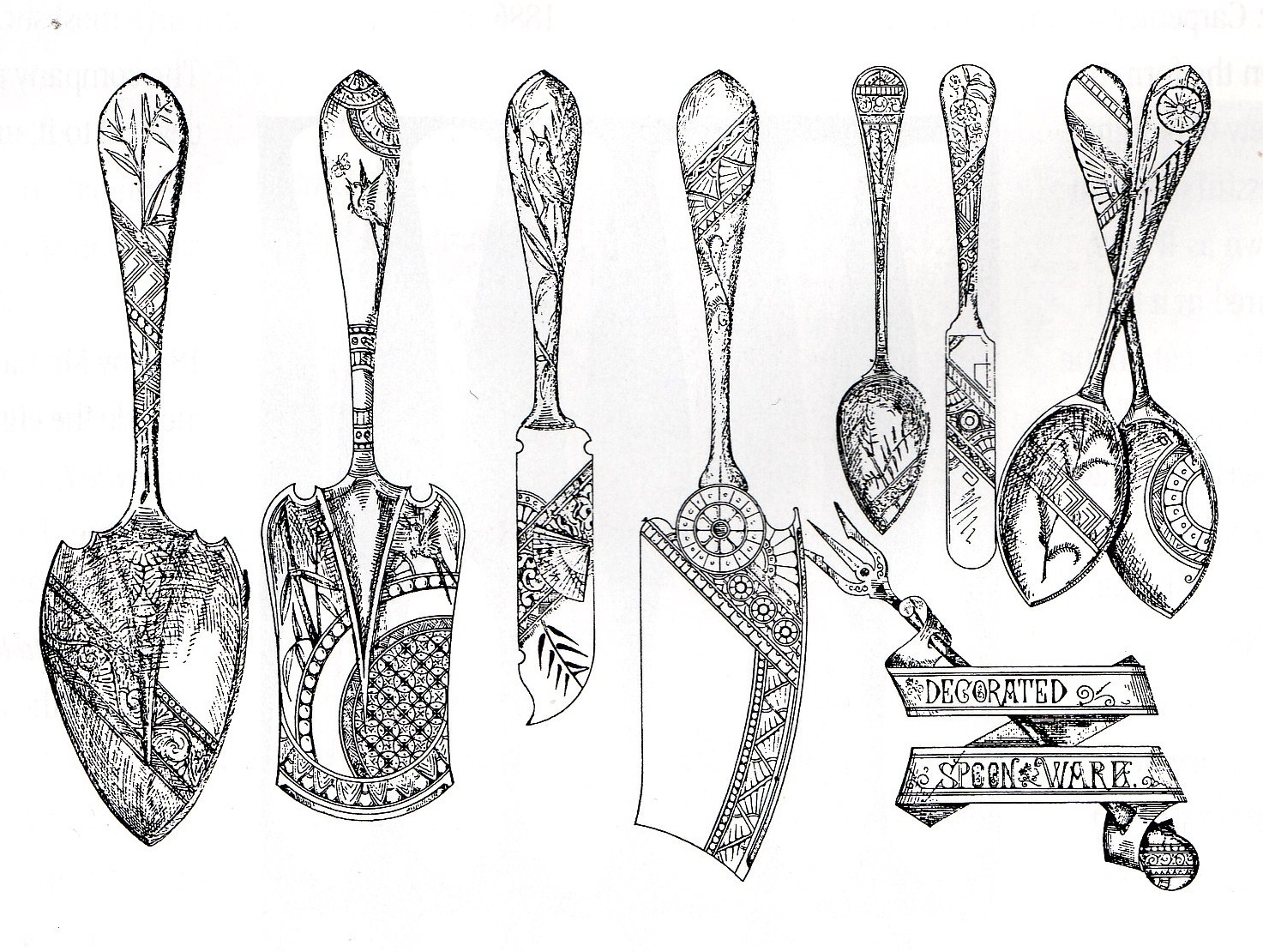
Tiffany has emerged triumphant as the most important American silver company today, but in the late 19th century they held equal court with other silversmiths such as Gorham, Whiting, and Wendt. By the late 1860s, all were creating numerous silver patterns and holloware pieces to follow the changing fads in American decorative arts — what is amazing is how quickly they adapted to each and every new trend. One of the most influential to sweep the nation was Japanese style and the silver makers were quick to follow.
I recently had the pleasure of re-examining a collection of John Wendt’s 1872 “Bird” pattern that I worked to assemble a number of years ago. This Japonesque pattern has a bamboo stem running up a simply shaped handle, with a swooping or plunging bird amidst assorted flora. If you look at the handles in the photos below, you can see that the bird varies from piece to piece. This was a very popular device in the Victorian era, called a “multi-motif” pattern. All teaspoons would be the same, but they would differ from the forks, from the knives, from the serving pieces, etc.
Ah, those serving pieces! The Victorians were not content with the “Five Piece Hostess Set” that comes with modern silverware. They had servers and individual place pieces for every food imaginable! There were three sizes of soup spoons – bouillon, cream and gumbo. Oyster forks, asparagus tongs, nut picks, cheese scoops, macaroni servers and Saratoga chip servers were all required. New technology in food storage and preparation made exotic foods available to the wealthy and having the right silver to serve it with demonstrated status to guests. Ice cream, which requires cold storage, was a newly available luxury and had its own special forks and spoons and elaborate servers, like this ice cream slice below.
In addition to the pattern on the handle, fancy servers would often have details etched or engraved on the blade. It is well worth clicking the photo above, and the pie server below, to see the wonderful Japoneseque engraving.
Sometimes, customers made bad choices as they could customize their purchases. The berry spoon below ia a bit of a hodge-podge as it was ordered with an Egyptian revival shaped bowl (the Victorians were not just influenced by Japanese design, they were interested in anywhere exotic and new to them) but with traditional rococo engraving. Definitely not as seamlessly beautiful as the two pieces above.
One charming aspect of collecting antique silver is the monograms and commemorations engraved in spaces on either the front or back, depending on the style of the pattern. Wendt’s “Bird” has space on the back, as this youth knife monogrammed “Frank” shows.
This large ladle was a silver anniversary present, engraved with the date February 2, 1853-1878.
Most likely “Bird” was not designed by John Wendt, as he sold his share of the company to his partner Bernard Beiderhase by 1871. But looking at Tiffany’s “Japanese” pattern sugar sifter below, do you think Mr. Beiderhase was creative in his design? Tiffany did not, and sued for design patent infringement.
To add to the confusion, Whiting entered the fray with their 1874 “Japanese” pattern.
All three patterns were multi-motif and all had realistically depicted birds, flowers and grasses. Tiffany’s pattern had reeds or grasses growing up the handle, as opposed to bamboo. And what about Gorham, you may ask? They too had a multi-motif pattern called “Japanese”, but took a very different design approach, although the birds and bamboo are still there on some of the pieces.
Seeing these extremely similar patterns together gives a real sense of how popular the Japanese aesthetic was. But like all trends, it fell out of favor and went relatively unnoticed for decades. Prices on today’s antique silver market once again show how highly Japonesque design is valued.
If you are interested in silver I highly recommend Charles Venable’s absolutely gorgeous book Silver in America: 1840-1940 A Century of Splendor. There is a fantastic “Bird” macaroni server on page 138. And for more on these patterns, see D. Albert Soeffing’s “The Battle of the Bird: An Investigation of the Bird /Japanese Patterns of the 1870s” in Silver Magazine Nov/Dec 1995.
Interested in the Japanese influence on Western decorative arts? See an earlier post Japan-a-mania…Cracked Ice and Crazy Quilts. The knife handle on Wendt “Bird” has a cracked ice pattern at the juncture point which can be seen on both the youth knife and the ice cream slice.
Many thanks to the silver collector who allowed me to photograph the collection.
Image credits: 1. reproduced in Silver Magazine May/June 1990, 2-8. me, 9-12 Romance With Silver, all items currently available for sale,












